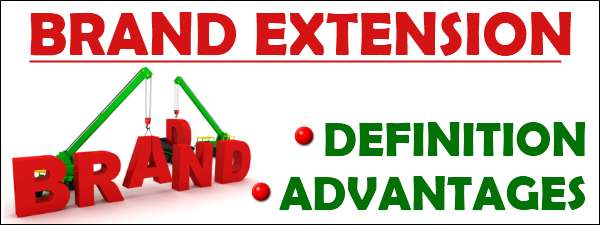Brand Extension | Meaning | Definition | Advantages | Disadvantages | Risks
Table of Contents
What is Brand extension?
The brand extension involves using an existing brand name to launch a product in a different category.

Brand extension relates to the process of product development by introducing minor product variations. The company uses its existing brand name for all its products such as automobiles, motor cycles, generators, marine engines, etc.
For example, Coca-Cola introduced Diet Coke as a brand extension strategy.
Brand Leverage vs Brand Extension
Brand leverage is the slight variation of brand extension. The original brand is launched into segments of the existing market and then into new markets.
For example,
- Yamaha products extended from motorbikes to musical instruments.
- The Tesco super market chain extended its brand to petrol retailing. It gained very good publicity for the brand owing to low pricing policies and a campaign supporting unleaded petrol.
Definition of Brand extension?
Brand extension is defined as
the use of a brand name established in one product class to enter another product class.
Experts view brand extensions as category extensions. The category extension refers to a situation when the parent brand is employed to make an entry into a different product category. The new product category needs to be different from the category presently served by the brand. An example of this is the name Tata being used for products ranging from salt to software.
Advantages or Benefits of Brand Extensions
Brand extension strategy delivers the following benefits.
1. Capitalize existing brand assets: When market entry barriers are high, a company through brand extension can achieve growth by capitalizing its existing brand assets.
2. Lower cost access to retail operation: Brand extension allows the retailing organization an easy and a lower cost access to an existing distribution. For example, traditional men’s wear brands have incorporated women’s wear into their ranges.
3. Economies in promotion and advertising: In the era of communication revolution, consumers are well aware of various brands available in the market. Brand extension involves introducing product variations of the existing brands offered in the market. So, there is no need to build public awareness afresh. Economies in promotion and advertising, therefore, accrue to organizations adopting brand extension strategies.
4. Gives an instant position and reputation: Existing brand name gives own products or new businesses an instant position and reputation. Consumers have confidence in existing brands. The existing confidence is instantly transferred to the new offer.
5. Extends perceived quality to the new offer: A product is a bundle of utilities. Consumer’s are prepared to buy a brand only when its price is worthy of its benefits. The quality, perceived by the consumer must match the quality of the existing retail offer, is transferred by the customer to the new product.
6. Reassures a prospective purchaser that the retail offer is well supported: Consumers recognize a brand name only when it is favorably perceived by them. A recognizable brand reassures a prospective buyer that the retail offer is well supported by the company. So, it encourages initial purchases.
7. Brand extension increases the probability of success: Drastic changes take place in marketing environment. A market witnesses the entry of competitors into it that adds to the growing complexity of competition. As a defense against competition and desire to grow, product launch becomes inevitable. But huge investments are required to develop and launch a new brand. By extending a brand the marketer can bring the costs down substantially while increasing the probability of success at the same time.
8. Extensions enhance promotional efficiency: Supporting a large number of individual brands will involve high costs. Its promotion cost structure will go up. Moreover, investment in one brand does not help the other brands. But under brand extension, an already established name is used to enter another product class. When the Dettol brand of soap is advertised, it indirectly benefits other brands under the same name. Further, at the time of new product launches, the name awareness already exists. So, it needs less advertising support in comparison with new brand launches.
9. By knowing the name, a customer can easily understand the performance delivery of a new brand: Brand extensions offer a less risky route to a new product category. When a customer is familiar with a brand, the customer knows what to expect from the brand. This is based on what the customer already knows about the brand.
When Kelvinator launched a new product, a microwave oven, customer would have been more comfortable in the context of expectations. Familiarity with a brand name reduces the risk perceived by the prospect in a buying situation.
10. Brand extensions immensely help parent brand:
Brand extensions are justified as they help parent brand in many ways
- The first and foremost benefit is that brand extensions bring clarity in brand meaning. It can in fact enlarge the product meaning. For example, J & J is not about baby soap, it is all about baby care. Likewise, IBM is not merely in the computer business but in the customer solution business.
- Secondly, extensions strengthen the brand’s bond with customers. It reinforces the brand image by adding this association.
11. Superior returns are generated from diversified brands: Many brands were initially a mono-product. Over time, the mono-activity evolved into a diversified structure. Walt Disney, for example was about animation films for children during the fifties. But now it has grown as a highly heterogeneous business. These include publishing, films, television, theme parks and cruises. It has been proved that focused brands earn less while diversified brands generate huge returns.
Disadvantages of brand extension
1. Brand extension may discourage innovation. It may lead to companies producing too many “lookalike” products.
2. Tho brand extension may dilute the value of the core brand. The company may extend into too many other product areas which may dilute their appeal.
3. The problem of cannibalization may arise. Company’s resources may be wasted by producing products which closely resemble the original. They may gain their sales at the expense of the original.
4. The company may be tempted to rely on the power of the core brand name. As a result, it may not give sufficient financial support to the extension.
5. Brand extension may have a spillover effect. The negative publicity for the original product adversely affects any other product with the same brand name.
6. An inappropriate extension is likely to cause negative association among the products with the same brand name. For example, Levi’s extension into suits. Another example is a cigarette company’s extension into health products.
7. Studies show that extensions are not as successful as the original brand.
Risks of brand extensions
Risks associated with brand extensions are two-fold:
1. The ability of the product to travel across products
2. Marketing a new product not neglecting the core business and overestimating the new brand.
As markets become more competitive, companies are forced to create diverse products portfolios.
For example,
- ITC extended from cigarette manufacturing to biscuits.
- Levi Strauss in the 1980s extended its brands from jeans dress materials into other clothing and shoes. As customers did not accept this, it returned to its core business.


